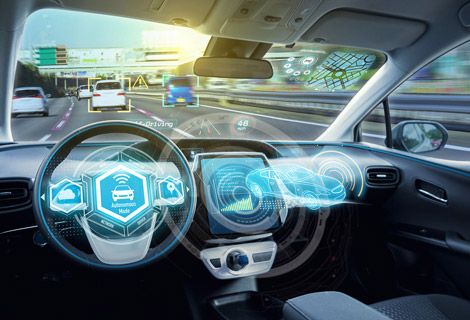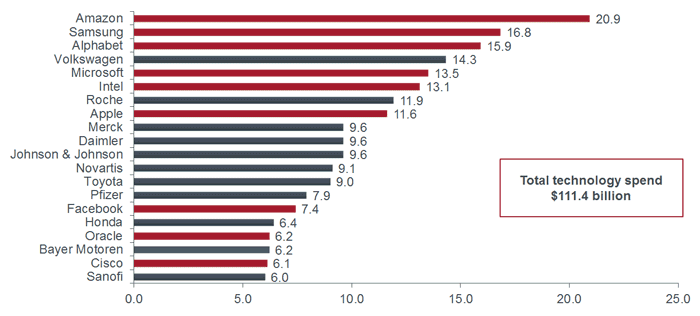
Janus Henderson: Disruptive forces - automotive innovation
The Janus Henderson Global Technology team discusses the latest technological advances set to disrupt the automotive sector after visiting the Consumer Electronics Show in Las Vegas.
25.02.2019 | 09:37 Uhr
A convergence of new technologies, a change in ownership preferences and increased focus on sustainability policies and safety are making the automotive industry ripe for further disruption.
The auto market is expected to grow to US$6.7 trillion by 2030 from US$3.5 trillion in 2015 with around 30% (US$1.5 trillion) of this revenue expected to be driven by emerging technologies*. Unlike previous periods of innovation in the sector, much of this new technology is not focused on the traditional mechanics of the vehicle but on the wider issues of user experience, safety and reduced emissions.There are four overriding technological trends that we are monitoring: autonomous driving, electrification of vehicles, infotainment/vehicle interaction, and shared ownership. These themes are inextricably linked - progress in one will drive progress in another and is expected to have a ripple effect on the wider technology sector.
Autonomous driving
According to projections, up to 15% of new cars sold in 2030 could be fully autonomous, while up to 70%* could have varying levels of automation for advanced safety and applications, such as parking assistance and lane switching. The evolution of fully autonomous driving depends on regulatory, technological, security and legal issues (such as insurance liabilities) as well as customer willingness to adopt and trust this technology over time.From a technology standpoint, the success of driverless vehicles relies on two important development areas: firstly, how the car gathers data about its surrounding environment; and secondly, how that data is processed.
Data collection: while there are a number of potential technologies that could aid this process, the adoption of multiple sensors around the vehicle is currently the most widely talked about solution. Examples of this are LiDAR (Light Detection And Ranging) technology, which uses lasers to measure the distance between the sensor and the target object, and radar technology, which uses radio waves to determine the range, angle or velocity of an object.Another potential way to collect data is through ‘vehicle-to-everything’ technology (V2X), a wireless technology aimed at enabling data exchanges between a vehicle and any entity in its surroundings (including other vehicles). This approach could, over time, reduce the amount of sensors required around the vehicle but requires a fast network to be able to function seamlessly. We believe the deployment of 5G could significantly change the dynamics in this area, and act as an enabler of connectivity for future autonomous vehicles.A further question raised by these potential developments is: where is the data stored? In the vehicle? In the environment surrounding it? What is the potential impact on cloud and storage companies?
Data processing: considering the large amount of data input required for autonomous vehicles, one of the biggest debates in the automotive and semiconductor industries is around the system underpinning the analysis of this data – will central or edge computing become more prominent?
Edge computing refers to having the data processing power at the edge of a network (on smart devices or edge devices) instead of holding that processing power in a cloud or a central data warehouse (central computing). Traditional CPU and GPU (central and graphics processing unit) type products would probably be more relevant if central processing is the chosen path. On the edge computing side, we will probably see a move towards cheaper and more integrated solutions. On the other hand, there could easily be a combination of both system architectures going forward.
Electrification
Although we are still in the early days of the Electric Vehicle (EV) revolution, we see it as a major theme within the market, driven by higher fuel efficiency needs as well as reduced carbon emissions for the environment.Tesla has pioneered the mass adoption of EVs, and we saw new EV models from other players including the Mercedes Benz EQC and the next generation Nissan Leaf e+ presented at the 2019 Consumer Electronics Show (CES) in January.In our opinion, the range, battery performance and overall cost of EVs are all vital drivers of mass adoption, as is the charging infrastructure. Hence we continue to monitor technological innovation around the Lithium-ion batteries (technology relevant for the range of vehicle), power semiconductors and the vehicle charging infrastructure.
Infotainment and vehicle interaction
As drivers become passengers, with more time to dedicate to themselves while in the vehicle, there is more focus on the user experience. Vehicles today are becoming a lot more like smartphones – increasingly equipped with integrated multi-media tools and built-in network capacity designed to improve the interaction with the driver. Social media, real-time traffic and dynamic routing systems are all at the user’s fingertips. Passenger interaction with the vehicle through voice control and other applications is also becoming more prevalent.At the CES last month, we saw huge screens for front dashboards in cars for infotainment as well as easier interaction with the vehicle. We also observed the adoption of smart assistant systems, such as Amazon Alexa and Google Assistant, within vehicles as another growing trend.
Shared ownership
Technology disruption in the automotive space is also resulting in a shift away from traditional car ownership to new, on-demand business models emerging today, such as shared mobility and robo-taxi. Robo-taxis are self-driving/driverless taxis operated for an e-hailing or on-demand mobility service.Will the ownership of autonomous vehicles sit with the robo-taxi type companies or with the individuals/users themselves? In our opinion, the former seems to be more likely in the nearer term, potentially on a five-year horizon. Individual ownership is likely to be a longer-term prospect, once more vehicles are on the market and autonomous vehicle costs have fallen.Digitisation and new business models have revolutionised other industries and the automotive sector will be no exception. We see many potential beneficiaries from the four overarching technological trends discussed here, including the likes of Tesla and Aptiv in the automotive vehicles market and NVidia, Intel, Ambarella, NXP Semiconductors and Infineon, among others, from a component perspective, as well as data and ecosystem players such as Amazon and Google.It is not only the technology providers themselves that are affected by this innovation, other automotive companies have been forced to spend more because of the threat of disruption. As the chart below shows, Honda, Toyota, Daimler and Volkswagen are all significantly increasing their research and development spend in response to the new trends of electric vehicles and, in the longer term, autonomous vehicles.
Top 20 global spenders on research and development (in USD billions)
Source: Bloomberg, as at 31 December 2018
Note: References made to individual securities should not constitute or form part of any offer or solicitation to issue, sell, subscribe or purchase the securityThe competition is what keeps technology growing and innovating. This is the technology flywheel that we often refer to – the gains that are driving superior earnings growth, enabling the strong balance sheets that provide the opportunity to protect a business or to enter new areas.
*Source: McKinsey & Company research, 2016.






Diesen Beitrag teilen: